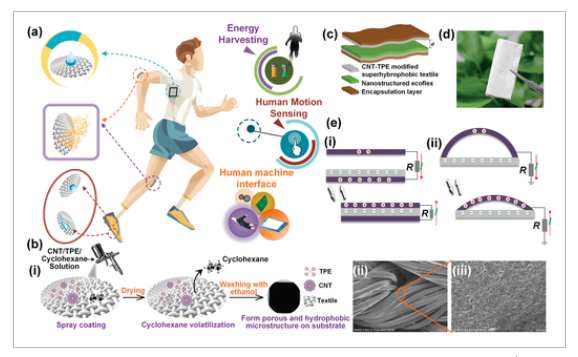文章专利

- 地址: 江苏省苏州市苏州工业园区若水路398号
- 邮箱: tzhang2009@sinano.ac.cn
- 电话: 86-512-62872706
- 传真: 0512-62603079
- 网址: http://nanosensor.sinano.ac.cn

Machine Learning Glove Using Self‐Powered Conductive Superhydrophobic Triboelectric Textile for Gesture Recognition in VR/AR Applications, Advanced Science, 2020, 7(14): 2000261.
Feng Wen#, Zhongda Sun#, Tianyiyi He, Qiongfeng Shi, Minglu Zhu, Zixuan Zhang, Lianhui Li, Ting Zhang,* Chengkuo Lee*
Abstract:
The rapid progress of Internet of things (IoT) technology raises an imperative demand on human machine interfaces (HMIs) which provide a critical linkage between human and machines. Using a glove as an intuitive and low‐cost HMI can expediently track the motions of human fingers, resulting in a straightforward communication media of human–machine interactions. When combining several triboelectric textile sensors and proper machine learning technique, it has great potential to realize complex gesture recognition with the minimalist‐designed glove for the comprehensive control in both real and virtual space. However, humidity or sweat may negatively affect the triboelectric output as well as the textile itself. Hence, in this work, a facile carbon nanotubes/thermoplastic elastomer (CNTs/TPE) coating approach is investigated in detail to achieve superhydrophobicity of the triboelectric textile for performance improvement. With great energy harvesting and human motion sensing capabilities, the glove using the superhydrophobic textile realizes a low‐cost and self‐powered interface for gesture recognition. By leveraging machine learning technology, various gesture recognition tasks are done in real time by using gestures to achieve highly accurate virtual reality/augmented reality (VR/AR) controls including gun shooting, baseball pitching, and flower arrangement, with minimized effect from sweat during operation.
 Full
Full
Article:https://onlinelibrary.wiley.com/doi/full/10.1002/advs.202000261
